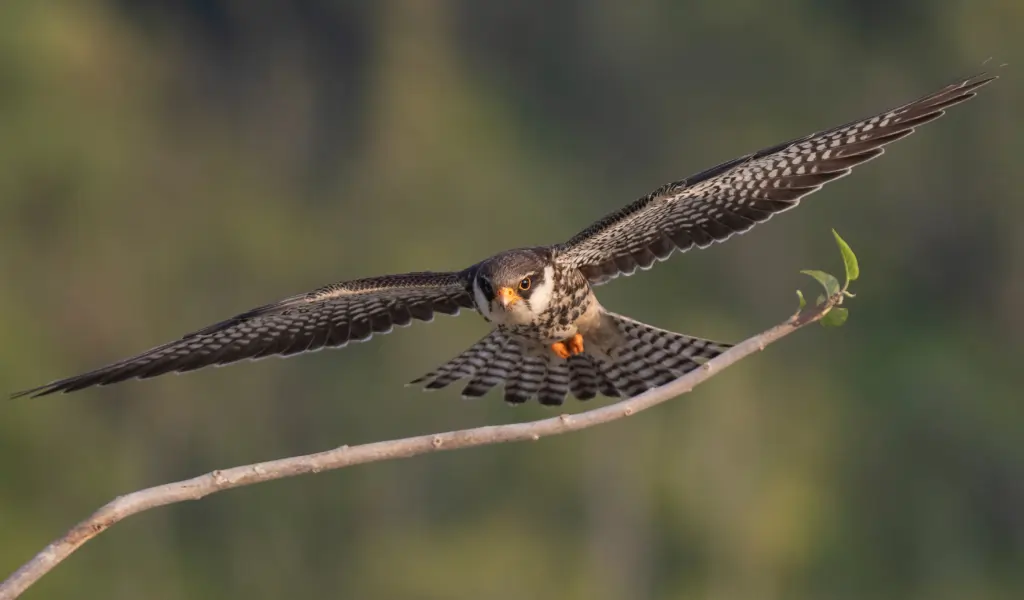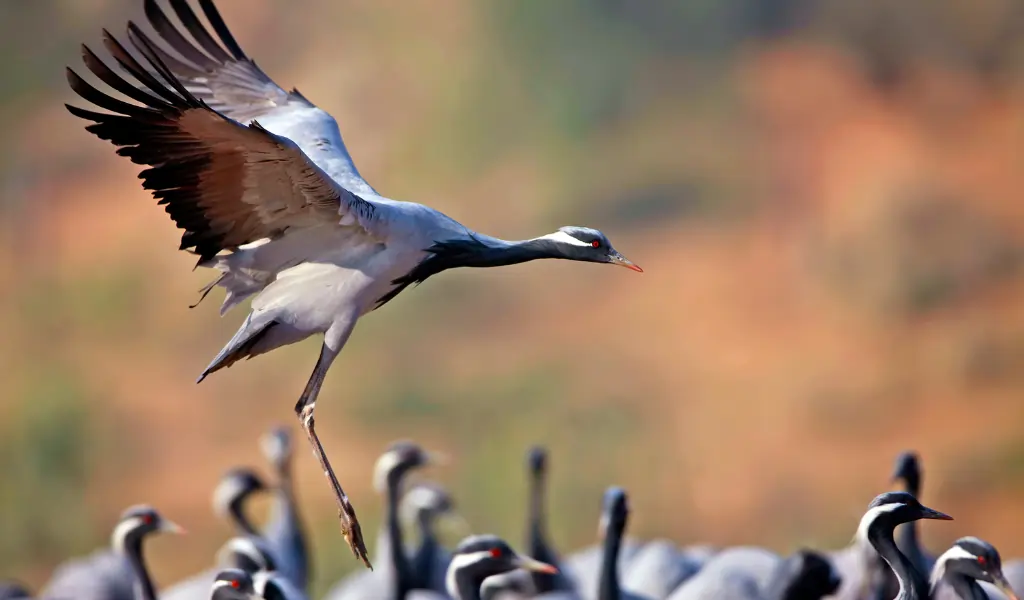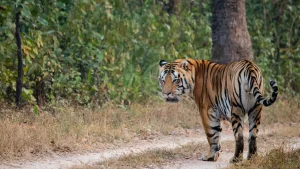India’s incredible biodiversity isn’t just something to observe, it’s something to experience. Every year, or sometimes only once in many years, the wild landscapes of this subcontinent come alive with spectacular natural wildlife events. From mass flowering on misty mountain slopes to the synchronized nesting of marine turtles under moonlight, and from epic migrations of raptors to grand congregations of elephants and cranes, these phenomena reveal a side of nature that is both majestic and humbling.
In this blog, we explore five of India’s most awe-inspiring natural wildlife events that bring together wildlife, landscapes, and people in a delicate dance of survival, tradition, and wonder.
Table of Contents
ToggleNeelakurinji Blooming: The Blue Carpet of the Western Ghats
Once every twelve years, the shola grasslands of the Western Ghats in Kerala and Tamil Nadu transform into a vast sea of blue. This is the legendary Neelakurinji blooming, an ecological phenomenon that is as poetic as it is scientific.
The star of the show is Strobilanthes kunthiana, a shrub found at altitudes between 1300 to 2400 meters. Most of the time, it grows unobtrusively, blending with the native vegetation of the region. But every twelfth year, millions of these plants synchronize their blooming cycles and burst into brilliant bluish-purple blossoms, carpeting the slopes of places like Eravikulam National Park, Munnar, Vattavada, and parts of the Nilgiris.
The last bloom occurred in 2018, drawing lakhs of visitors, scientists, and photographers from across the globe. The next full flowering is expected in 2030. The phenomenon isn’t just a visual treat it is ecologically significant. The mass flowering triggers a surge in pollinators like bees and butterflies, influences seed dispersal cycles, and even impacts the feeding behavior of certain herbivores.
For locals and tribals, blooming holds cultural importance too. In some traditions, it is seen as a symbol of abundance, while in others it marks a generational milestone, many in the region say you are lucky to witness it more than twice in a lifetime.
The Neelakurinji is also a reminder of the fragility of montane grassland ecosystems, many of which are being lost to tourism infrastructure and invasive plantations. Preserving the shola-grassland mosaic is essential not just for the flowers, but for a host of endemic species like the Nilgiri tahr, black-and-orange flycatcher, and the laughingthrushes that depend on this unique habitat.
Flight of the Amur Falcons: North-East India’s Sky Spectacle
Every October, the skies of Nagaland and parts of Manipur and Assam darken—not with storms, but with the arrival of Amur falcons, one of the world’s most remarkable migratory birds. These small raptors undertake an astonishing 22,000-kilometer journey from Siberia to southern Africa, passing through India as a critical stopover.
The Doyang Reservoir in Nagaland has become the most famous site to witness this wildlife event, where tens of thousands of Amur falcons roost communally on electric lines, trees, and hill slopes. Their arrival is not just a visual spectacle but a symbol of a conservation success story.
Just a decade ago, Amur falcons were being trapped and slaughtered in large numbers during their migration halt. However, a concerted effort led by local communities, NGOs, and the Nagaland Forest Department transformed the narrative. Awareness programs, compensation schemes, and citizen engagement turned hunters into protectors. Today, the same villages that once threatened the falcons now celebrate their arrival with festivals, photography tours, and pride.
Ecologically, the stopover is vital for the birds, as they feed on dragonflies and other insects to build energy for their transoceanic journey. For conservationists, the wildlife event is a model of community-driven conservation, proving that lasting change is possible when local people are included as stewards of biodiversity.
Arribada: Olive Ridley Sea Turtles Storm Odisha’s Shores
Imagine a quiet beach under a full moon, the only sounds being the waves and the soft shuffling of thousands of turtles emerging from the sea. This is Arribada, a mass nesting wildlife event unique to Olive Ridley Sea turtles, and India is home to one of the largest such sites in the world.
Every year between February and April, the coasts of Odisha particularly Gahirmatha Beach, Rushikulya, and the Devi River mouth witness the arrival of hundreds of thousands of female turtles. Under cover of darkness, they dig shallow pits in the sand and lay up to 100 eggs each, before returning to the ocean.
A few weeks later, the beach comes alive again as hatchlings emerge en-masse, instinctively scuttling toward the sea. It’s a moment of beauty and peril, only a fraction of these tiny turtles survives the gauntlet of predators and pollution.
Conservationists have been working for decades to protect these turtles through nesting beach patrols, awareness programs, and regulation of fishing activities. Light pollution, mechanized trawling, and climate change-induced sea level rise continue to pose serious threats. However, efforts by the Odisha Forest Department, local volunteers, and national wildlife organizations have helped boost survival rates significantly.
Witnessing arribada is a humbling experience. It speaks to the resilience of nature and the urgency of preserving delicate marine ecosystems for generations to come.
Kabini’s Gathering Giants: Elephant Congregation in Summer
As summer sets in and water sources dry up across the forests of southern India, Kabini Backwaters in Karnataka become a refuge, an oasis that draws together one of Asia’s largest congregations of wild Asian elephants.
Situated on the fringes of the Nagarhole Tiger Reserve, the Kabini reservoir retains water even in the harshest months. This attracts elephants in huge numbers, often seen in herds of 50 to 100 individuals, including mothers with calves, dominant bulls, and sub-adults. The dry season, typically March to May, offers unmatched sightings of wild elephants engaging in complex social behavior, bathing, dusting, sparring, and communicating through low-frequency rumbles.
Kabini has become a hotspot for wildlife photographers and elephant researchers alike. It provides a unique window into elephant ecology, such as seasonal migration, matriarchal bonding, and the challenges of human-wildlife interface.
Conservation in this landscape is multi-layered. While Nagarhole is a protected tiger reserve, the surrounding areas are under pressure from tourism, agriculture, and development. Efforts are now being made to enhance habitat connectivity between Nagarhole, Bandipur, and Wayanad reserves through wildlife corridors. The Kabini congregation is a living testament to why such connectivity is crucial not just for elephants, but for the entire ecosystem they help maintain.
Feathered Diplomacy: Demoiselle Cranes in Khichan, Rajasthan
In the stark desert landscape of Rajasthan, the small village of Khichan becomes a winter sanctuary for an elegant visitor ‘the Demoiselle Crane’. From October to February, over 30,000 of these cranes fly in from Mongolia and Central Asia, creating a daily spectacle of grace and gratitude.
What makes this migration truly extraordinary is the role played by the villagers themselves. For decades, the people of Khichan have fed the cranes daily, offering grains in a designated feeding ground. The wildlife event is deeply embedded in the local Jain traditions of Ahimsa (non-violence) and compassion for all life forms.
At sunrise, cranes gather in flocks on the dunes, trumpeting softly as they wait for their daily meal. Then, in synchronized rhythm, they glide down to the feeding ground, hundreds at a time—while onlookers watch in reverent silence. The afternoon sees them retreat to nearby fields or water bodies before returning for their evening flight to roost.
The arrival of the cranes has not only become an ecological wildlife event but also a cultural and economic opportunity. Birdwatchers and tourists flock to Khichan to witness the phenomenon, bringing income to the local economy while also inspiring citizen conservation movements.
The success of Khichan offers a blueprint for community-led wildlife stewardship, where tradition and conservation walk hand in hand.
Also visit: Amazing wildlife destination in India
Conclusion: Nature’s Calendar Is Alive
Each of these wildlife events is a reminder that nature operates on a clock far more ancient and intricate than our own. Whether it is a 12-year blooming, a month-long migration stop, or a seasonal congregation, these phenomena reflect the rhythms of the Earth—and the urgent need to keep those rhythms intact.
To witness them is to witness the harmony of life, the balance of ecology, and the interconnectedness of species. But as climate change, habitat fragmentation, and human encroachment continue to disrupt these delicate patterns, the responsibility falls on all of us to ensure that such wonders remain part of India’s wild heritage.
Plan your travels with care, support local conservation, and most importantly, observe with respect. Nature rewards the patient and the passionate—and in India, its offerings are as timeless as they are unforgettable.
Give a read to Best guide for your next India Tiger Safari Tour.















